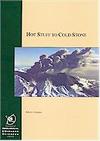
Hot Stuff to Cold Stone
This book explores the differences between igneous rocks. It concentrates on their ancestry and development, as well as the glories of volcanic processes. Where the rocks come from, where they go to, and how they get there, are covered along with their inherited genes, adolescent phases, and neighbourhood stresses.
Fortunately, most rocks contain clues to their own history within them. Igneous comes from the Latin ''ignis'', meaning fire. Igneous rocks form when magma, hot molten material from the depths of the planet, cools and hardens. When magma becomes solid below ground, the results are plutonic rocks, which are coarse grained because they cool slowly. When magma solidifies above ground, it creates volcanic rocks. These are finer grained because they cool faster. Granite is a common plutonic rock, and basalt is a common volcanic rock.
The other major rock families are sedimentary and metamorphic. Sedimentary means to ''settle in, to sit'' in Latin, and sedimentary rocks are made from the eroded bits of existing rocks. Metamorphic means ''change of form'' in Greek. Metamorphic rocks are igneous or sedimentary rocks that have been squashed and/or cooked so much that their original structure and composition have changed. Igneous rock can be considered the ancestral rock type. The others 'descend' from existing rocks (cold and solid), but the igneous pedigree goes back to magma - the original hot stuff.
$49.90